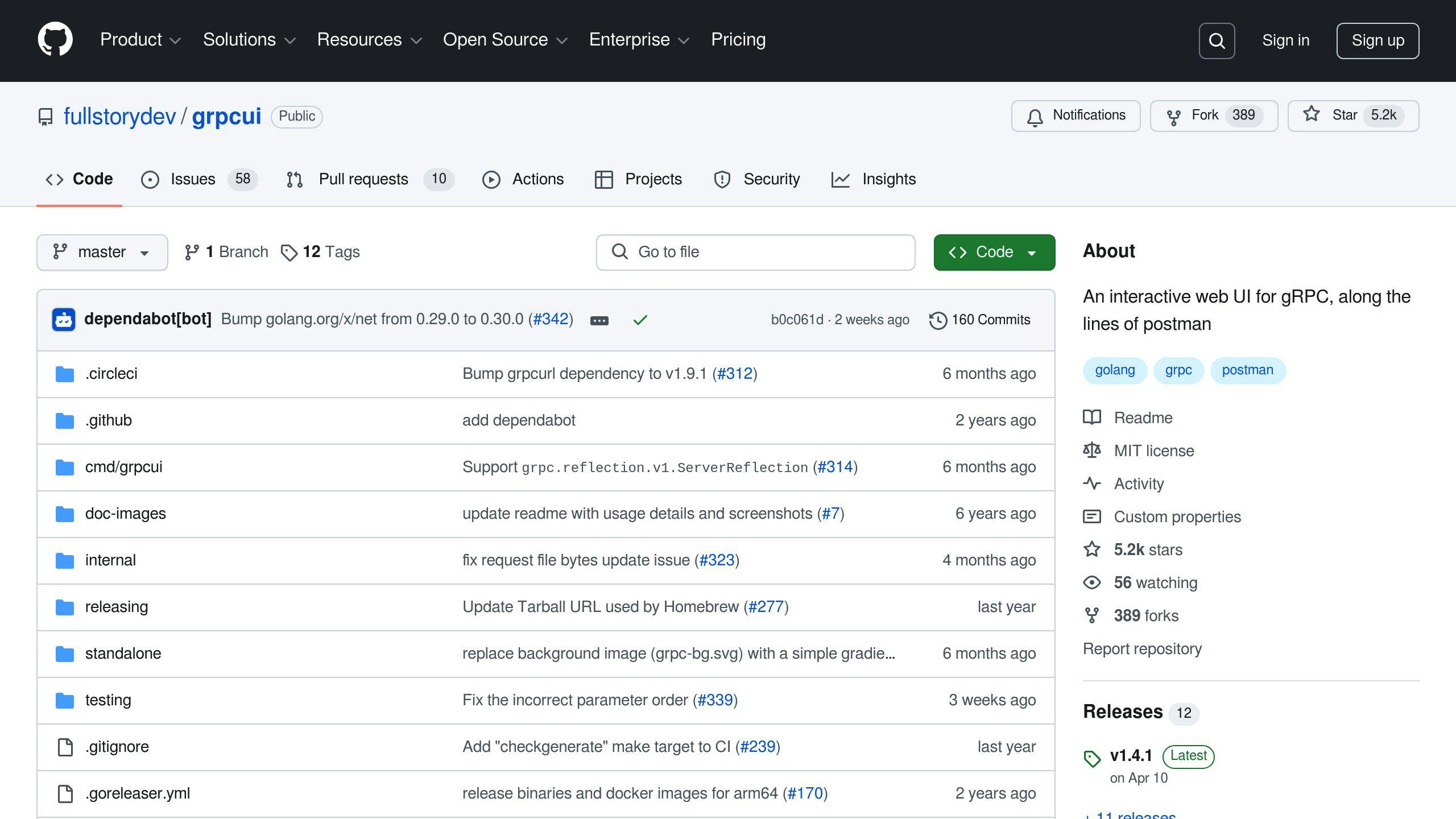Here's what you need to know about gRPC error handling in ASP.NET Core:
- Use status codes to signal success or failure
- Implement rich error handling with structured info
- Set up interceptors for centralized error management
- Always use SSL/TLS and keep error messages vague in production
- Continuously improve your error handling practices
Key components:
| Component | Purpose |
|---|---|
| StatusCode | Indicates error type |
| Status | Combines code and description |
| RpcException | Represents server-side errors |
Common errors to watch out for:
- Network problems
- Security issues
- Timeout errors
- Server and client misconfiguration
Best practices:
- Use appropriate status codes
- Provide detailed error information
- Implement interceptors for logging
- Set up retry policies
- Track and monitor errors
- Handle streaming errors properly
- Have fallback plans
Remember: Good error handling isn't just about catching exceptions - it's about providing useful feedback and maintaining security.
Related video from YouTube
Common gRPC Errors in ASP.NET Core

When using gRPC in ASP.NET Core, you might run into a few common errors. Let's break them down:
Network Problems
These are usually the first issues you'll face:
Grpc.Core.RpcException: Status(StatusCode='Internal', Detail='Error starting gRPC call. HttpRequestException: TypeError: Failed to fetch')
This error? It's telling you the client couldn't connect. Maybe the server's down, or there's a network issue.
Security Errors
SSL/TLS problems can be a headache. Make sure your gRPC client uses HTTPS for secured services. And remember: only ignore invalid certificates in development!
Timeout Issues
gRPC lets you set request timeouts. But watch out - HttpClient in .NET has a 100-second default timeout. Long-running calls might get cut off:
RPC failed: Status{code=DEADLINE_EXCEEDED, description=deadline exceeded after 1.970455800s, cause=null}
Fix it by increasing HttpClient.Timeout or using Timeout.InfiniteTimeSpan.
Server Errors
If the server throws a non-RpcException, you'll get this unhelpful message:
Exception was thrown by handler
Not great for debugging, right? Catch specific exceptions on the server and use responseObserver.onError(..) for better error messages.
Client Errors
Client errors often come from misconfiguration. For example:
unavailable: possible missing connect.WithGRPC() client option when talking to gRPC server
This happens when a Connect client calls a grpc-go server without the right setup. Double-check your client options!
How to Handle gRPC Errors Well
Handling gRPC errors isn't rocket science. But it does need some thought. Here's how to do it right:
Use the right status codes
gRPC uses status codes to tell you what went wrong. Pick the right ones:
INVALID_ARGUMENTfor bad inputNOT_FOUNDwhen something's missingDEADLINE_EXCEEDEDfor timeouts
Give details
Want to say more? Use Google.Rpc.Status. It lets you send complex error info from server to client:
var status = new Google.Rpc.Status
{
Code = (int)Code.InvalidArgument,
Message = "Bad request",
Details =
{
Any.Pack(new BadRequest
{
FieldViolations =
{
new BadRequest.Types.FieldViolation { Field = "name", Description = "Value is empty" }
}
})
}
};
throw status.ToRpcException();
Use interceptors
Interceptors are like middleware. They let you handle errors the same way across your app. Here's one for logging:
public class ServerLoggerInterceptor : Interceptor
{
private readonly ILogger _logger;
public ServerLoggerInterceptor(ILogger<ServerLoggerInterceptor> logger)
{
_logger = logger;
}
public override async Task<TResponse> UnaryServerHandler<TRequest, TResponse>(
TRequest request,
ServerCallContext context,
UnaryServerMethod<TRequest, TResponse> continuation)
{
try
{
return await continuation(request, context);
}
catch (Exception ex)
{
_logger.LogError(ex, $"Error in {context.Method}");
throw;
}
}
}
Retry when things fail
Use Polly to retry when things go wrong. Here's a simple retry policy:
var retryPolicy = Policy
.Handle<RpcException>(ex => ex.StatusCode == StatusCode.Unavailable)
.WaitAndRetryAsync(3, retryAttempt =>
TimeSpan.FromSeconds(Math.Pow(2, retryAttempt)));
Track errors
Log errors. Monitor them. Use tools like Application Insights or Serilog. They'll help you spot and fix issues fast.
Handle streaming errors
For streaming calls, handle errors both ways. Here's how on the server:
public override async Task StreamingMethod(
IAsyncStreamReader<TRequest> requestStream,
IServerStreamWriter<TResponse> responseStream,
ServerCallContext context)
{
try
{
while (await requestStream.MoveNext())
{
// Process request
}
}
catch (Exception ex)
{
await responseStream.WriteAsync(new TResponse { Error = ex.Message });
}
}
Have a Plan B
Always have a backup plan:
- Cache data you use a lot
- Use default values when data's missing
- Use circuit breakers to stop failures from spreading
Setting Up a Main Error Handler
Let's set up a main error handler for gRPC in ASP.NET Core. This approach makes error management a breeze across your app.
Here's how:
1. Create a custom interceptor
Make a class to catch and log errors from all gRPC services:
public class ServerLoggerInterceptor : Interceptor
{
private readonly ILogger<ServerLoggerInterceptor> _logger;
public ServerLoggerInterceptor(ILogger<ServerLoggerInterceptor> logger) => _logger = logger;
public override async Task<TResponse> UnaryServerHandler<TRequest, TResponse>(
TRequest request,
ServerCallContext context,
UnaryServerMethod<TRequest, TResponse> continuation)
{
try
{
return await continuation(request, context);
}
catch (Exception ex)
{
_logger.LogError(ex, $"Error in {context.Method}");
throw;
}
}
}
2. Register the interceptor
In Startup.cs, add:
services.AddGrpc(options =>
{
options.Interceptors.Add<ServerLoggerInterceptor>();
options.EnableDetailedErrors = true;
});
3. Use rich error handling
For complex errors, use Google.Rpc.Status:
var status = new Google.Rpc.Status
{
Code = (int)Code.InvalidArgument,
Message = "Input validation failed",
Details =
{
Any.Pack(new BadRequest
{
FieldViolations =
{
new BadRequest.Types.FieldVilation { Field = "name", Description = "Name is required" }
}
})
}
};
throw status.ToRpcException();
4. Implement a global exception handler
Create a GlobalExceptionHandler:
public class GlobalExceptionHandler : IExceptionHandler
{
private readonly ILogger<GlobalExceptionHandler> _logger;
public GlobalExceptionHandler(ILogger<GlobalExceptionHandler> logger) => _logger = logger;
public async ValueTask<bool> TryHandleAsync(HttpContext context, Exception exception, CancellationToken cancellationToken)
{
_logger.LogError(exception, "An error occurred: {Message}", exception.Message);
var problemDetails = new ProblemDetails
{
Status = StatusCodes.Status500InternalServerError,
Title = "An error occurred",
Detail = exception.Message
};
context.Response.StatusCode = StatusCodes.Status500InternalServerError;
await context.Response.WriteAsJsonAsync(problemDetails, cancellationToken: cancellationToken);
return true;
}
}
5. Register the global exception handler
In Program.cs, add:
builder.Services.AddExceptionHandler<GlobalExceptionHandler>();
builder.Services.AddProblemDetails();
And there you have it! A solid error handling setup for your gRPC services in ASP.NET Core.
sbb-itb-29cd4f6
Testing Error Handling
Let's dive into three ways to test error handling in gRPC services: unit testing, integration testing, and manual testing.
Unit Testing
Unit tests focus on specific parts of your gRPC service. Here's a quick example:
[Fact]
public async Task SayHelloUnaryTest()
{
var mockGreeter = new Mock<IGreeter>();
mockGreeter.Setup(m => m.Greet(It.IsAny<string>())).Returns((string s) => $"Hello {s}");
var service = new TesterService(mockGreeter.Object);
var response = await service.SayHelloUnary(new HelloRequest { Name = "Joe" }, TestServerCallContext.Create());
mockGreeter.Verify(v => v.Greet("Joe"));
Assert.Equal("Hello Joe", response.Message);
}
This test mocks dependencies, calls the service method, and checks the response.
Integration Testing
Integration tests look at the whole flow of your gRPC app. Here's how to set one up:
[Fact]
public async Task SayHelloUnaryIntegrationTest()
{
var client = new Tester.TesterClient(Channel);
var response = await client.SayHelloUnaryAsync(new HelloRequest { Name = "Joe" });
Assert.Equal("Hello Joe", response.Message);
}
This test uses a real gRPC client to call the service, testing the entire request-response cycle.
Manual Testing with gRPCui

For quick tests, gRPCui is a great tool. It gives you a web interface to interact with gRPC services. To use it:
- Install gRPCui
- Run your gRPC server
- Launch gRPCui:
grpcui -plaintext localhost:5000
This opens a web UI where you can pick methods, input data, and see responses.
Tips for Better Error Handling Tests
- Test different error scenarios
- Check error codes and messages
- Test your interceptors
- Try different environments
Keeping Error Handling Secure
Security is key when handling errors in gRPC apps. Bad error messages can spill secrets. Here's how to lock it down:
Encrypt Everything
Use SSL/TLS. It's that simple. No snooping on your error messages.
"Security isn't just nice to have. It's a must-have in today's digital world."
Keep It Vague in Production
gRPC doesn't spill the beans by default. Keep it that way. For debugging:
// Dev only!
app.UseGrpcWeb(new GrpcWebOptions { EnableDetailedErrors = true });
Double-Check IDs
Use mTLS. Both sides prove who they are. Extra safe.
Clean User Input
Check what users send you. Both sides. No funny business.
Lock Down Logs
Logs can leak. Here's the fix:
| Do This | Why |
|---|---|
| Mask Sensitive Stuff | No real names, card numbers, or passwords |
| Encrypt Logs | Keep stored logs safe |
| Limit Who Sees What | Not everyone needs full access |
| Check Regularly | Catch mistakes early |
Use a Privacy Vault
One place for sensitive data. Keeps it out of logs and errors.
No Secrets in Public
Don't store login info where anyone can see it. Use secure config for machine-to-machine talks.
Wrap-up
Let's recap the key points of error handling in gRPC for ASP.NET Core:
1. Status Codes
gRPC uses status codes to signal success or failure. OK means success, others indicate errors.
2. Rich Error Handling
Go beyond basic status codes. Use structured error info for more detailed feedback.
3. Interceptors
These catch errors before they reach the client. Great for centralized error management.
4. Security
Always use SSL/TLS. Keep error messages vague in production.
5. Keep Improving
Error handling isn't set-and-forget. It needs ongoing work.
Here's a quick reference:
| Component | Purpose |
|---|---|
| StatusCode | Error type |
| Status | Code + description |
| RpcException | Server-side error |
Good error handling isn't just about catching exceptions. It's about useful feedback and security. As gRPC expert Anthony Giretti says:
"The usage of Interceptor, RpcException, StatusCodes and Trailers gives us a certain flexibility, like customizing errors and the possibility to send relevant errors to the client."
Keep working on your error handling. It'll make your gRPC apps in ASP.NET Core stronger and more user-friendly.
FAQs
What is gRPC core RpcException?
RpcException is gRPC's way of saying "Oops, something went wrong." It pops up when the server hits a snag and needs to tell the client about it.
Here's the deal:
- Server can't find what the client asked for? INVALID_ARGUMENT.
- Taking too long to respond? DEADLINE_EXCEEDED.
RpcException comes with a Status value - it's like a note explaining what went wrong.
Anthony Giretti, a gRPC guru, puts it this way:
"RpcException is thrown in many scenarios: The call failed on the server and the server sent an error status code. For example, the gRPC client started a call that was missing required data from the request message and the server returns an INVALID_ARGUMENT status code."
How to send error in gRPC?
In gRPC, you've got three main players for error handling:
| Type | What it is | What it does |
|---|---|---|
| StatusCode | List of error types | Tells you if it's OK or what kind of oops |
| Status | StatusCode + message | Gives more details about the error |
| RpcException | Exception with Status | The actual error you throw or catch |
Here's how to use them:
On the server, throw an RpcException:
throw new RpcException(new Status(StatusCode.InvalidArgument, "Hey, you forgot something!"));
On the client, catch that RpcException:
try
{
// Your gRPC call here
}
catch (RpcException ex)
{
Console.WriteLine($"Uh-oh: {ex.Status.StatusCode} - {ex.Status.Detail}");
}
That's error handling in gRPC - simple, right?


